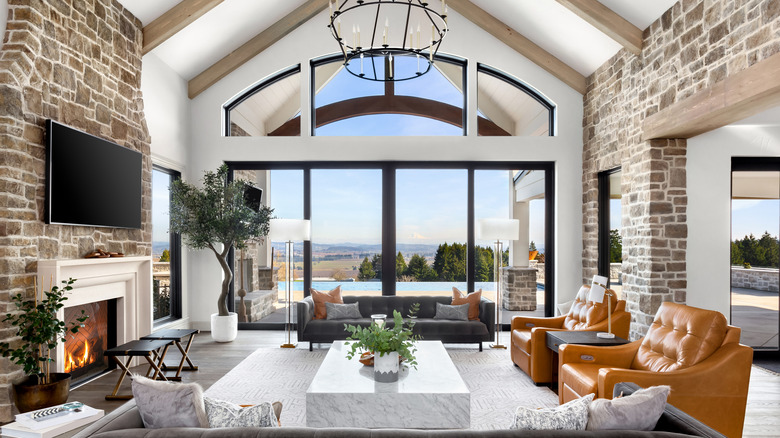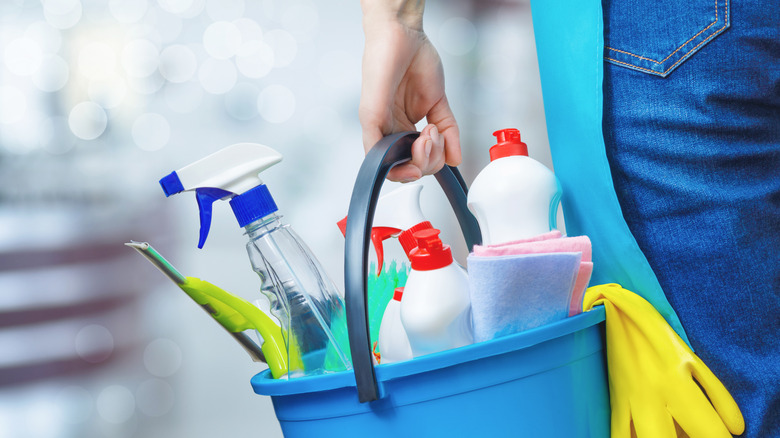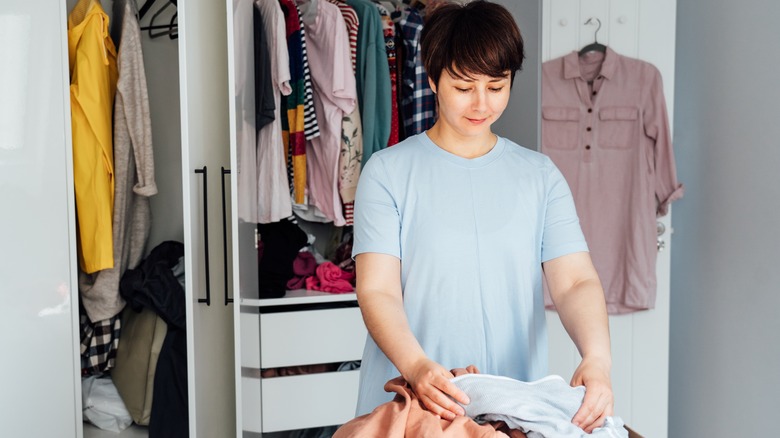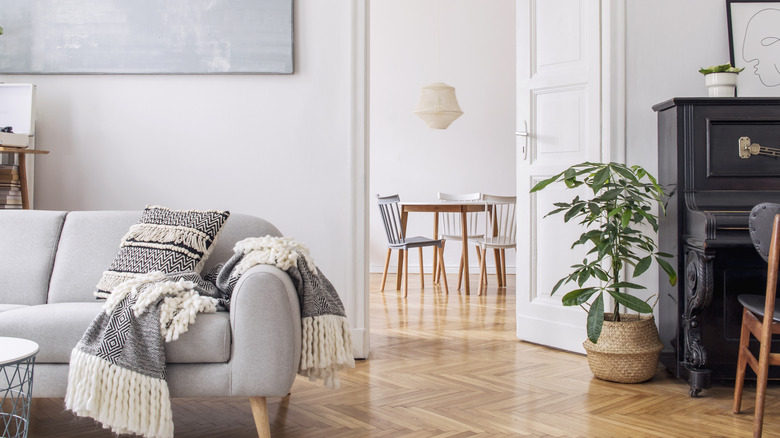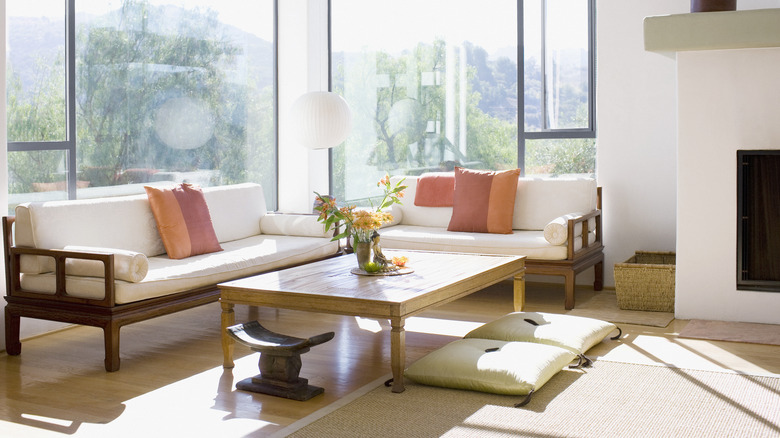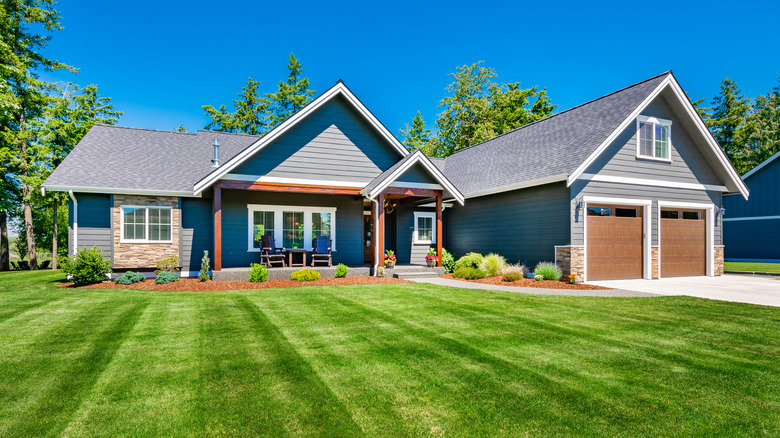How To Stage Your Home Like A Professional, According To Real Estate Experts
If you're considering selling your home and want to do so quickly, home staging could be a valuable tool. Investopedia states that the goal of staging a home is twofold: Make the home attractive to as many people as possible and, second, ensure those that place an offer on the home do so at a high price point. Many companies offer this service and paying someone else to do it can be worth it to some. But if you want to keep costs down while still getting the results, you'll need a few home staging tips.
Karen Broussard and Kristin Rosmorduc, co-founders of NoVa Home Sellers at Keller Williams Dulles in northern Virginia, provided some steps to staging like a professional in an exclusive interview with House Digest. "Staging is often misconstrued. People think they need to spend a lot of money to rent furniture and make a home look like a model," they share. "While the goal of showing off a home's best features is a good one, it can often be done on a budget by following a handful of simple principles."
Clean your space and make necessary repairs
Before doing anything else, start with the basics. Karen Broussard and Kristin Rosmorduc share that cleaning is a priority. "There may be no better advice for staging a home. There's nothing less inviting than dirt and grime." This can be an instant distraction for someone touring the house. The team recommends a much higher quality clean than just every day tidying up. "Pay for a professional carpet cleaning and a full deep clean of the home, focusing especially on making the kitchen and bathrooms sparkle. Grout should be clean, and tubs, showers, and areas around sinks should be caulked. Pay particular attention to areas under sinks, as prospective buyers do look in these spaces," they explain.
Another common area of concern is obvious repairs or things that wouldn't likely cost much to fix but would otherwise hinder the buying decision. Make necessary repairs, Broussard and Rosmorduc state. "Yes, this is an important part of staging. People don't want to see dripping faucets, cracked tile, or broken hinges on cabinets."
Remove all clutter and personal items
The next step in staging a home doesn't have to cost you anything, most often. Since you plan to move anyway, getting some of your personal items packed up now makes sense. Karen Broussard and Kristin Rosmorduc share their insights on managing clutter and personal items. "Remove any knick knacks, personal photos, memorabilia, and paperwork. The idea is for potential buyers to imagine themselves in your home, and it's hard for them to do that when there are too many distractions or personal effects."
When deciding what to leave behind and what to pack away, follow one bit of advice from Broussard and Rosmorduc. "Less is more. You want your home to be like a hotel — with minimal and well-chosen accessories. That also means clearing out closets as much as you can to make them look bigger." The more material you remove from the home in general, the larger the entire house can feel.
Arrange your furniture to make rooms look more spacious
As you're working on decluttering your home, also take the time to get rid of anything you won't need between now and when you move out. If you're okay with packing it away, do so. Karen Broussard and Kristin Rosmorduc offer insight into what to leave behind. "Remove excess pieces of furniture that aren't necessary, sticking with the basics like a couch, a couple of chairs, and a few tables in the living room, for example. In kitchens, most items should be removed from the countertop." If you'll need to use that coffee maker daily, keep it accessible but tuck it into a cabinet out of sight when potential buyers arrive.
In addition to making the rooms of your home look larger, getting rid of those extras can help people to envision themselves as they walk through the home, often imagining what it would be like to live there. The team also shares advice on this." Ensure nothing is blocking the walkways through your rooms — or from one room into another."
Brighten things up
With all of the "extras" out of the way, the next step in staging is to let the light in. Karen Broussard and Kristin Rosmorduc have a few tips about how to do that. "If there isn't much natural light or recessed lighting in a room, brighten things up with a few well-placed tabletop or floor lamps. If yours look dated, invest in some new lamps that are more current." You don't want the items you leave behind to make your home seem dated or old, as that could make the potential buyer feel like there's a lot of work to be done.
When possible, use your windows wisely. Broussard and Rosmorduc state, "Always let in as much natural light as possible when taking professional photos and opening up the home for showings. Raise blinds or shades, open shutters, and pull curtains to the side," they share. "Don't underestimate the positive effect of a fresh coat of paint in a light, neutral tone. It will do wonders to freshen up a room."
Boost your curb appeal
Many people focus on staging the home's interior, but the exterior can be just as important, if not more so. Karen Broussard and Kristin Rosmorduc explain, "Don't forget to focus on curb appeal by giving the outside of your home some TLC. At a minimum, make sure the grass is nicely mowed, leaves and debris picked up, beds mulched, and shrubs pruned." A good clean-up helps the potential buyer see what the exterior has to offer.
You'll also want to take a closer look at the actual exterior structure, too. Broussard and Rosmorduc offer some guidance on the most important areas to focus on sharing, "Gutters should be cleaned, the exterior of the home power washed, and windows professionally cleaned (in that order)." They continue, "Ensure the mailbox is sturdy, walkways are in good shape, decks and patios are power washed, and the front door is freshly stained or painted. These will be a buyer's first impressions."
